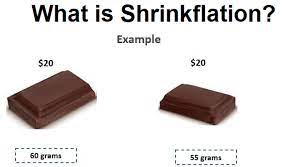What Is Shrinkflation?

Due to rising costs many companies are practising “Shrinkflation”.
- Shrinkflation is the practice of reducing the size of a product while maintaining its sticker price.
- It is a form of hidden inflation.
- Raising the price per given amount is a strategy employed by companies, mainly in the food and beverage industries, to stealthily boost profit margins or maintain them in the face of rising input costs.
- Shrinkflation is also referred to as package downsizing in business and academic research.
- A less common usage of this term may refer to a macroeconomic situation where the economy is contracting while also experiencing a rising price level.
- Macroeconomics is the study of the behaviour of a national or regional economy as a whole.
- It is concerned with understanding economy-wide events such as the total amount of goods and services produced, the level of unemployment, and the general behaviour of prices.
- Nowadays, shrinkflation is a common practice among producers.
- The number of products that undergo downsizing increases every year.
- Large producers in the European and North American markets rely on this strategy to maintain the competitive prices of their products without significantly reducing their profits.
- At the same time, shrinkflation can frequently lead to customer frustration and deteriorating consumer sentiment regarding the producer’s brand.
- Rising production costs are generally the primary cause of shrinkflation.
- Increases in the cost of ingredients or raw materials, energy commodities, and labour increase production costs and subsequently diminish producers’ profit margins.
- Reducing the products’ weight, volume, or quantity while keeping the same retail price tag can improve the producer’s profit margin.
- At the same time, the average consumer will not notice a small reduction in quantity. Thus, sales volume will not be affected.
- Fierce competition in the marketplace may also cause shrinkflation.
- The food and beverage industry is generally an extremely competitive one, as consumers are able to access a variety of available substitutes.
- Therefore, producers look for options that will enable them to keep the favour of their customers and maintain their profit margins at the same time.




